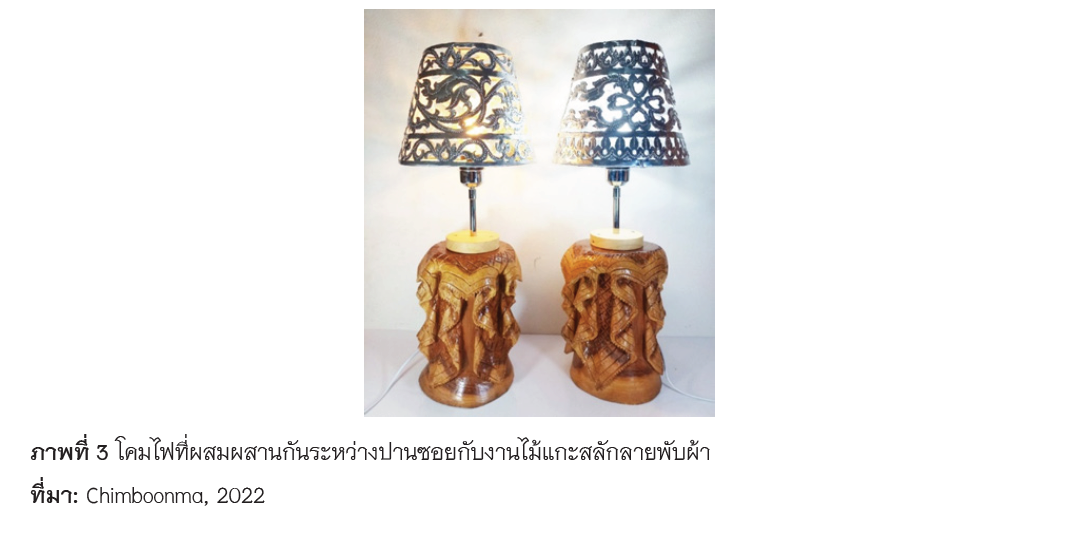The Development of a Process for Transmitting the Pan Soi Craft in Mae Hong Son Province
Main Article Content
Abstract
The purposes of this research were to: 1) find guidelines to develop products to generate income for the community, 2) develop a career plan for Pan Soi crafting through a research process, and 3) develop the career transmitting process; the Pan Soi occupation. The researcher proceeded according to the research methodology in 3 phases; Phases 1: finding guidelines to develop products to generate income for the community and assessing satisfaction with product development guidelines. Phases 2: develop a career plan for Pan Soi crafting through a research process. The feasibility of the plan was assessed by five experts. Phases 3: developing the process of transmitting the Pan Soi craft by conducting in-depth interviews with 30 Pan Soi artisans and crafts persons to assess the accuracy and suitability of the process. Research findings found that: 1. there were 3 guidelines to develop products to generate income for the community; 1) Pan Soi product design by applying local materials; 2) the combination of local wisdom between Pan Soi and other wisdom; and 3) the application of Pan Soi products should be contemporary, could be sold as appliance or souvenirs. The overall of satisfaction average was at the highest level. 2. The career development plan consisted of 6 components; 1) principles; 2) objectives; 3) operating procedures; 4) guidelines for Parn Soi occupation development; 5) career transmitting process; and 6) evaluation. The overall quality assessment of career transmitting process was at the highest level of possibility. 3. There were six stages of career transmitting “Pan Soi Process”; 1) preparing; 2) attitude; 3) new Ideas; 4) skills; 5) observations; and 6) innovative thinking. The overall quality assessment of career transmitting process was at the highest level of accuracy and suitability.
Downloads
Article Details

This work is licensed under a Creative Commons Attribution-NonCommercial-NoDerivatives 4.0 International License.
The articles published are copyrighted by the Graduate School, Chiang Mai Rajabhat University.
The opinions expressed in each article of this academic journal are solely those of the individual authors and do not reflect the views of Chiang Mai Rajabhat University or its faculty members. The responsibility for the content of each article rests entirely with the respective authors. In the event of any errors, the authors alone are responsible for their own articles.
References
Chaemkrajang, S., Yodnil, S., and Sudprasert R. (2015). Participatory action research (PAR): Integrates community plans into three-year planning. (B.E. 2558-2560) Bang Phra Subdistrict Municipality,
Si Racha District, Chonburi Province. Journal of Education and Social Development, 10(2), 200-211. [In Thai]
Chimboonma, P. (2021). The Model of teaching process for sheet-metal plates: Parn Soi Mae Hong Son Province. Chiang Mai: Faculty of Science and Technology. Chiang Mai Rajabhat University. [In Thai]
Chimboonma, P. (2022). The development of teaching process, sheet-metal plates: Parn Soi, Mae Hong Son province. Chiang Mai: Faculty of Science and Technology. Chiang Mai Rajabhat University. [In Thai]
Cohen, J. M. and Uphoft, N. T. (1977). Rural development participation: concept and measures for project design, implementation and evaluation. (Rural Development Monograph No.2). Ithaca NY: Rural Development committee center for international Studies, Cornell University.
Nonaka, I. and Toyama, R. (2003). The knowledge-creating theory revisited: Knowledge creation as a synthesizing process. Journal of Knowledge Management Research & Practice, 1(1), 2-10.
Jamjai, A., Sakuntanaka, P., and Suwatanpornkul, I. (2021). A study of the phenomenon of transferring creativity from local wisdom in Bangkok. Journal of Social Science and Buddhistic Anthropology, 6(6), 156-174. [In Thai]
Kaosol, N. (2018). Thai local wisdom and evolution of boats. Journal of Chandrakasemsarn, 24(46), 30-45. [In Thai]
Koocharoenpisal, N., Butsai, S., and Kuman, S. (2018) Development of the science activity packages based on local wisdom to develop learning outcome of 5th grade students. Journal of Graduate Studies Valaya Alongkron Rajabhat University, 12(2), 117-134. [In Thai]
Kumjudpai, S. (2010). Participatory action research to develop a model for developing teachers with the ability to organize learning that emphasizes thinking: A case study of Ban Tha Wat School. “Kururat Bamrungwit” Sakon Nakhon Educational Service Area Office 1. Rajabhat Sakon Nakhon University Journal, 2(3), 50-66. [In Thai]
Lavong, A., Chatukul, A., Chajchawanpanich K., Pholkerd, P., and Watcharapongkasem, V. (2021). Product development guideline referring to local identity for competitiveness in Sawai-Chek community enterprise, Muang Distirct, Buriram. Interdisciplinary Management Journal Faculty of Management Science, Buriram Rajabhat University, 5(1), 23-32. [In Thai]
Namjaidee, S. (2022). An analysis of the role of personal media in transferring knowledge and working wisdom Pak Thong Chai silk Nakhon Ratchasima Province. Community Research Journal, 16(1), 104-115. [In Thai]
Pomthongkam, S. (2009). Art source 2 Painting in Mae Hong Son Province. Chiangmai: Charat Thurakit. [In Thai]
Royal Academy. (2003). Royal Institute Dictionary, 1999. Bangkok: Nanmee Books Publishing.
Saenchai, P. (2011). The process of transferring knowledge of hand-woven cotton handicrafts to the community Ban Don Luang, Lamphun Province. Chiangmai: Chiangmai University. [In Thai]
Saithep, K. and Permthai, P. (2017). Guideline for the community product development for export of artificial. Journal of Modern Management Science, 10(2), 1-11. [In Thai]
Sricharoenpramong, S., Yingyong R., and Thipsot, S. (2020). Guidelines for developing local products to link with tourism in the Ban Bang Kacha community Chanthaburi Province. Rajabhat Chiang Mai Research Journal, 21(2), 157-166. [In Thai]
Srimanee K. (n.d.). Thai Yai pattern art. n.p.: Mae Hong Son. [In Thai]


